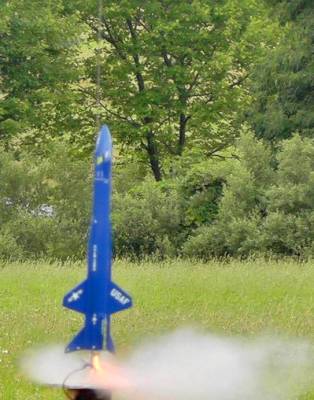The X-15: This is a "Sport-Scale" (not true scale) model of the famous X-15 rocket-powered research plane. This particular kit appears to be newer than other Quest X-15 kits described here: It is a few inches longer, and a recommendation by Quest to only use the A8-3 or A6 motors. (Mine is definitely too heavy to fly on an A8). I chose to paint my particular model gloss blue (not the historically accurate black).
My kit came out pretty heavy as I used a full-sized can of Rustoleum 2X paint trying to get a smooth, glossy finish. Apparently light coats of this paint leave the finish in something like an orange-peel texture, cool but not good for low drag. I discovered heavy, thick coats that would run with normal paints made for a smoother, glossy finish. But by then, there was so much primer and paint on this model that it almost doubled the weight of this kit. In MHO, Rustoleum 2X (from Home Depot) sucks for flying models. I wish I would have used the ridiculously expensive yet lighter Testors stuff at $5 for a tiny 3-oz. can.
The X-15 finally got a payload section addition. This adds another 3 inches to the rockets overall length. This will hold the Altimeter Two, which no longer is at risk of ejection shock damage or loss if the clip fails. The added bulkhead, painted payload tube and padding only adds an additional 13.6 grams of weight to this model.
She flies well and is not affected by the wind much, though I wish I could get her to venture a little closer to the clouds. Actual measurements with an altimeter on board shows this model can go much higher than I estimated, with a C6-3 it reached 437 feet, and traveled at 89 mph. That's enough to have it fly higher than the Great Pyramid of Giza, now that it has eroded about 25 feet.
| Flight Date: | 2012-06-30 |
| Rocket Name: | X-15 |
| Kit Name: | Quest - X-15 {Kit} (2014) |
| Flyer's Name: | Rich DeAngelis |
| Motors: | C6-3 |
| Expected Altitude: | 335 Feet |
| Wind Speed: | 10.00 mph |
| Launch Site: | Fort Indiantown Gap, PA |
| Actual Altitude: | 391 Feet |
By now the wind was strong and persistent, making flying anything high or slow a one-way mission to a bad place. But I knew this Quest X-15 could handle it. She’s heavy and seems to just brush-off wind gusts like a brick lighthouse.
It had a good 2 second burn, and although it rocked and quivered, it continued straight – really straight up. It accelerated at 7.1 Gs peak, and 2.1 Gs average. After motor burnout, moving at 91 mph, it still kept going straight up for another 3.8 seconds! At 372 feet the ejection fired early, and 4/10 seconds later it peaked at 391 feet apogee. It probably could have used a -5 delay even in this wind.
The parachute popped out, but it looked a little funny and was falling in an odd way. After about two or three seconds, the parachute appeared fully open. Apparently it got a bit tangled in the Nomex protection sheet until the winds opened them up. The descent was a normal 9 mph, and the flight time was 31.7 seconds. It landed about 240 feet from the pad due to drifting in the stronger winds. This is a good flight to end a long, hot and windy day.
| Stage | Motor(s) |
|---|---|
| 1 | Estes C6-3 |
 |
 |
